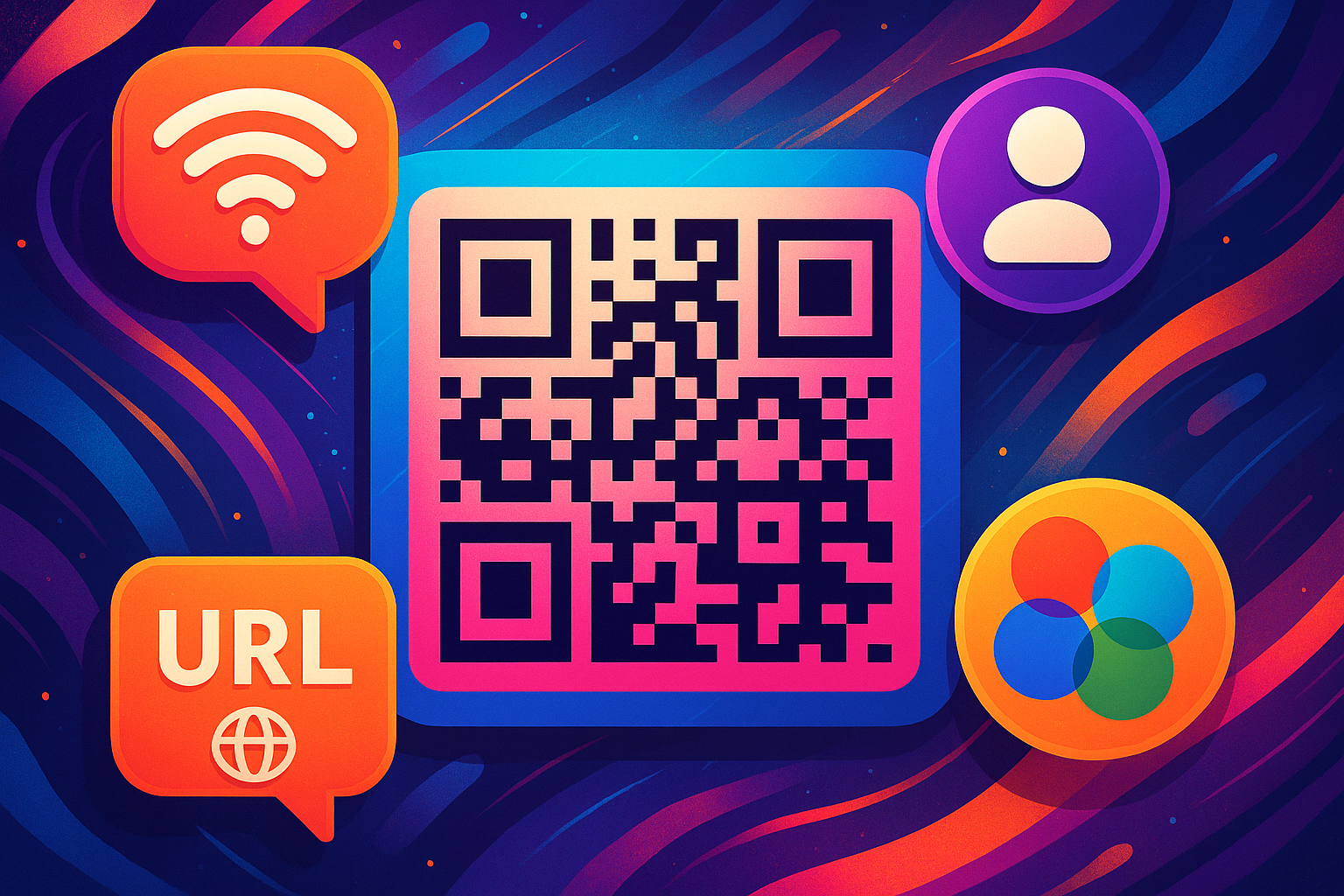QR Code Generator: Complete Guide and Best Practices
What are QR Codes?
QR (Quick Response) codes are two-dimensional barcodes that can store various types of information in a machine-readable format. Originally developed for the automotive industry in Japan, QR codes have become ubiquitous in modern digital communication due to their versatility and ease of use.
Types of QR Code Data
1. URL/Website Links
The most common use case for QR codes:
https://example.com
https://www.mywebsite.com/products
2. Plain Text
Simple text messages:
Hello World!
Welcome to our store
3. Email Addresses
Create mailto links:
mailto:contact@example.com
mailto:support@company.com?subject=Support Request
4. Phone Numbers
Direct dial functionality:
tel:+1234567890
tel:+44123456789
5. SMS Messages
Pre-filled text messages:
sms:+1234567890?body=Hello from QR Code
6. WiFi Network Information
Share WiFi credentials:
WIFI:T:WPA;S:NetworkName;P:Password;H:false;;
WIFI:T:WEP;S:NetworkName;P:Password;;
WIFI:T:nopass;S:OpenNetwork;;
7. Geographic Coordinates
Location data:
geo:40.7128,-74.0060
geo:40.7128,-74.0060?q=New York City
8. Contact Information (vCard)
BEGIN:VCARD
VERSION:3.0
FN:John Doe
ORG:Company Name
TEL:+1234567890
EMAIL:john@example.com
URL:https://johndoe.com
END:VCARD
9. Calendar Events (vCalendar)
BEGIN:VEVENT
SUMMARY:Meeting
DTSTART:20241215T100000Z
DTEND:20241215T110000Z
DESCRIPTION:Project discussion
LOCATION:Conference Room A
END:VEVENT
QR Code Best Practices
1. Choose the Right Size
- Minimum size: 2cm x 2cm for print
- Digital displays: At least 150x150 pixels
- Distance factor: QR code should be 1/10th of scanning distance
2. Ensure Sufficient Contrast
- High contrast: Dark modules on light background
- Avoid: Light colors on dark backgrounds
- Test: Verify readability in different lighting conditions
3. Add Error Correction
QR codes support four levels of error correction:
- L (Low): ~7% recovery capability
- M (Medium): ~15% recovery capability (default)
- Q (Quartile): ~25% recovery capability
- H (High): ~30% recovery capability
4. Include a Call-to-Action
- "Scan to visit our website"
- "Scan for WiFi access"
- "Scan to save contact"
5. Test Before Publishing
- Test with multiple devices and QR code readers
- Verify in different lighting conditions
- Check readability from various distances
Common QR Code Formats
WiFi Configuration
WIFI:T:[WPA/WEP/nopass];S:[SSID];P:[Password];H:[Hidden];;
Examples:
WIFI:T:WPA;S:MyNetwork;P:MyPassword123;H:false;;
WIFI:T:nopass;S:PublicWiFi;;;
Geographic Location
geo:[latitude],[longitude]
geo:[latitude],[longitude]?q=[query]
Examples:
geo:40.7128,-74.0060
geo:40.7128,-74.0060?q=Empire State Building
Contact Information
BEGIN:VCARD
VERSION:3.0
FN:[Full Name]
ORG:[Organization]
TEL:[Phone Number]
EMAIL:[Email Address]
URL:[Website]
ADR:;;[Street];[City];[State];[Postal Code];[Country]
END:VCARD
Security Considerations
1. URL Verification
- Always verify the destination URL before scanning
- Be cautious of shortened URLs (bit.ly, tinyurl)
- Use QR code readers that preview URLs
2. Malicious QR Codes
- Can redirect to phishing websites
- May download malware
- Could trigger unwanted actions
3. Best Practices for Users
- Use reputable QR code reader apps
- Preview URLs before visiting
- Be cautious in public spaces
- Avoid scanning codes from untrusted sources
QR Code Design Tips
1. Customization Options
- Logo embedding: Add small logos in the center
- Color schemes: Use brand colors while maintaining contrast
- Shape variations: Round corners, custom patterns
2. Branding Guidelines
- Keep logos small (10-30% of QR code area)
- Maintain sufficient error correction
- Test readability after customization
3. Print Considerations
- Vector formats: Use SVG or EPS for scalability
- Resolution: Minimum 300 DPI for print
- Paper quality: Avoid glossy surfaces that cause glare
Technical Specifications
Data Capacity
- Numeric: Up to 7,089 characters
- Alphanumeric: Up to 4,296 characters
- Binary: Up to 2,953 bytes
- Kanji: Up to 1,817 characters
Version Information
- QR codes range from Version 1 (21x21 modules) to Version 40 (177x177 modules)
- Higher versions can store more data but require larger physical size
Error Correction Codes
- Reed-Solomon error correction
- Allows recovery of damaged or partially obscured codes
- Trade-off between data capacity and error correction level
Mobile Integration
iOS Integration
- Native camera app supports QR code scanning
- Control Center QR code scanner
- Shortcuts app for custom QR actions
Android Integration
- Google Lens integration
- Camera app QR scanning
- Third-party QR code apps
Business Applications
1. Marketing Campaigns
- Product information and reviews
- Social media connections
- Promotional offers and coupons
2. Event Management
- Digital tickets and check-ins
- Event schedules and information
- Networking and contact exchange
3. Retail and E-commerce
- Product authentication
- Quick reordering
- Customer feedback collection
4. Restaurant Industry
- Digital menus
- Table ordering systems
- Payment processing
QR Code Analytics
Tracking Options
- Click-through rates
- Geographic data
- Device information
- Time-based analytics
Tools for Analytics
- Google Analytics UTM parameters
- Dedicated QR code platforms
- Custom tracking solutions
Accessibility Considerations
1. Visual Accessibility
- Provide alternative text descriptions
- Ensure sufficient color contrast
- Offer alternative access methods
2. Physical Accessibility
- Position codes at appropriate heights
- Ensure clear sight lines
- Provide adequate space for scanning
Future of QR Codes
Emerging Trends
- Dynamic QR codes with changeable content
- Enhanced security features
- Integration with augmented reality
- Blockchain-based verification
Technology Evolution
- Higher data density formats
- Improved error correction
- Better integration with IoT devices
- Enhanced visual customization
QR codes have evolved from simple inventory tracking tools to versatile digital bridges connecting physical and digital experiences. Understanding their capabilities, limitations, and best practices ensures effective implementation across various use cases.

